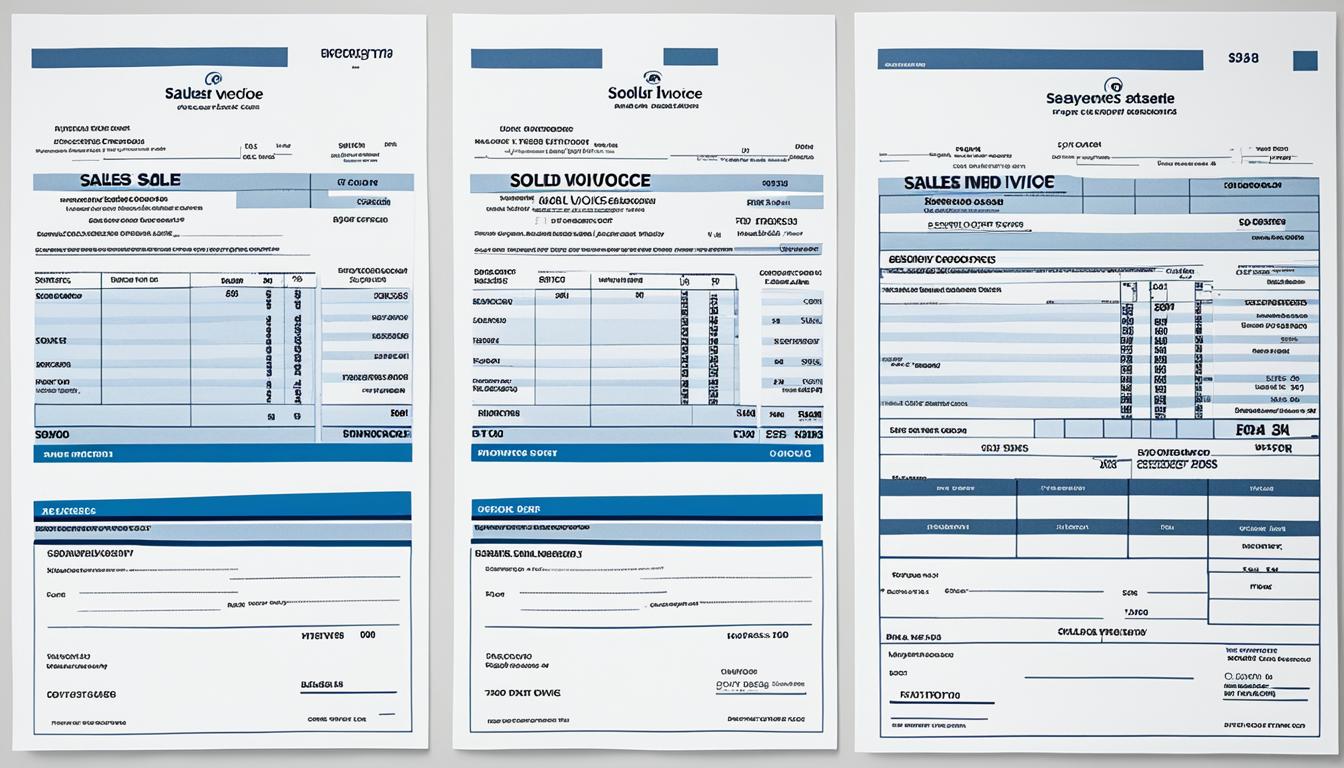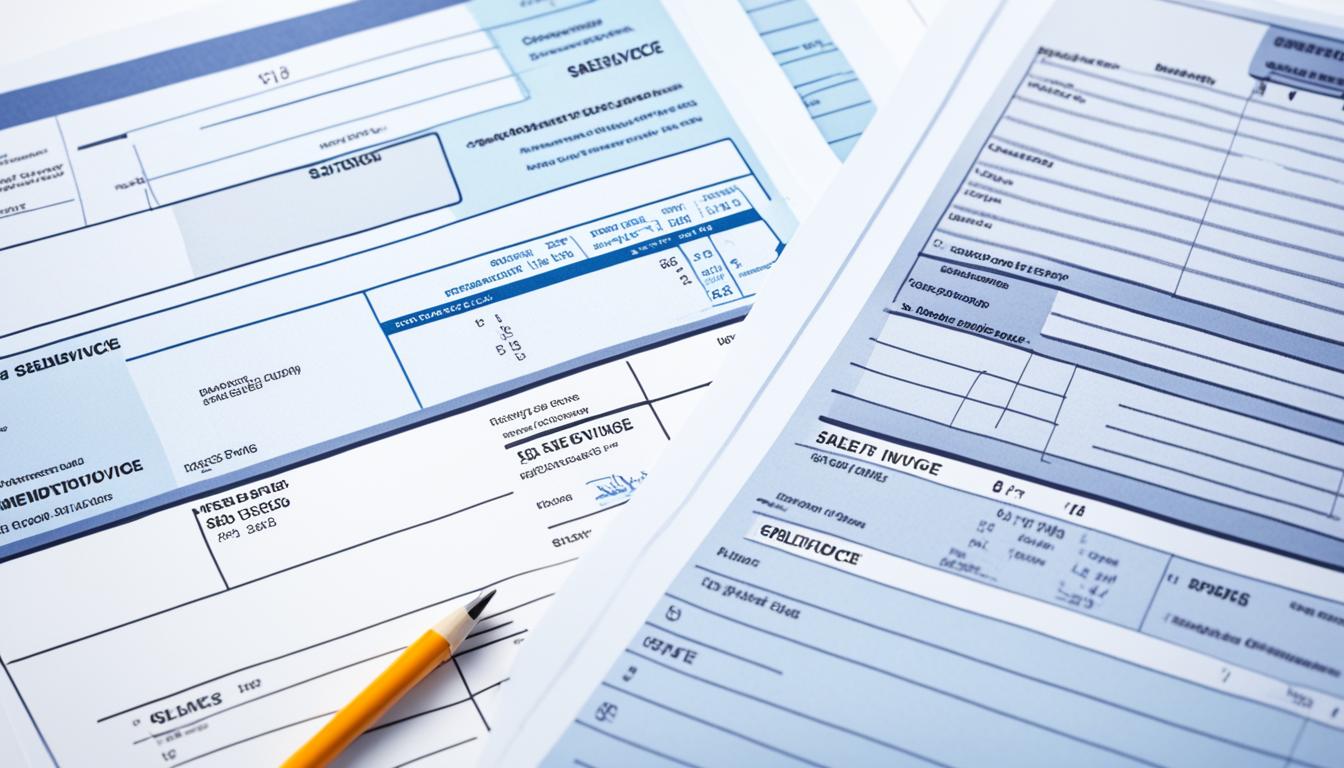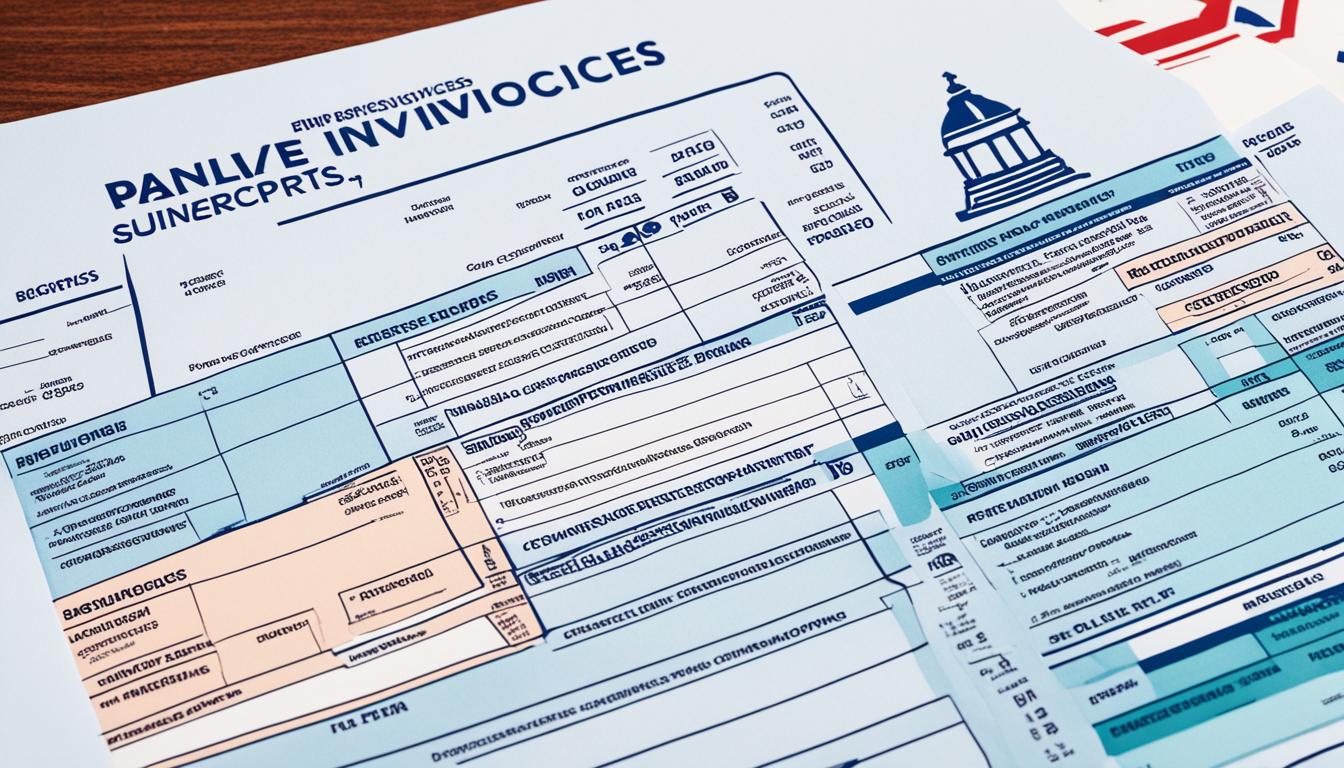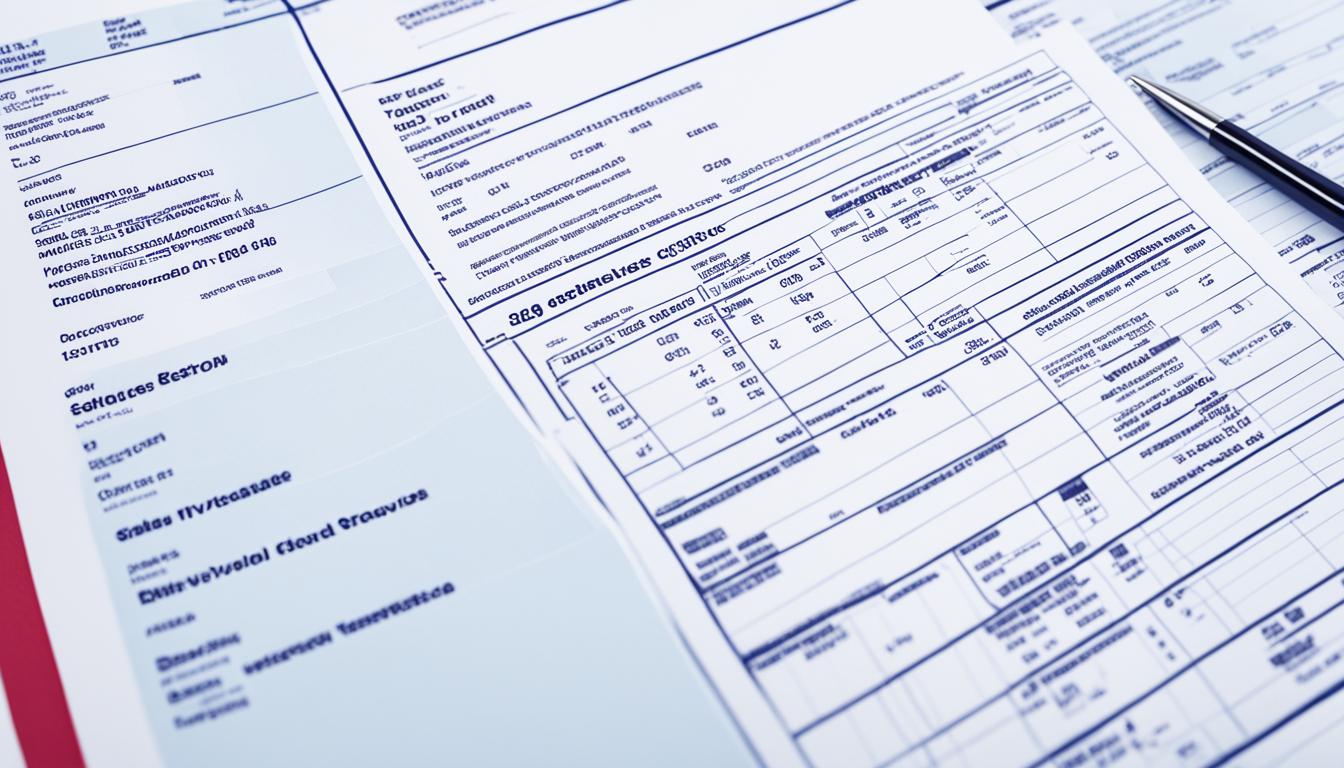Do you wonder if a sales invoice is the same as an official receipt?
In the business world, it’s key to know the difference between a sales invoice and an official receipt. They are critical in financial dealings. Let’s discuss their major differences.
First off, let’s talk about sales invoices. This document shows what was bought, how much, and the price. It also lists any taxes or discounts. The seller gives it to the buyer to ask for payment.
Now, let’s look at official receipts. They prove someone has paid for something. A seller gives this to the buyer. It shows the purchase date, payment details, and the item or service bought. This receipt is important for accounting and taxes.
These papers have different jobs. Knowing their roles is vital for keeping finances straight and following the law.
Key Takeaways:
- A sales invoice and an official receipt are two different documents with distinct roles in financial transactions.
- A sales invoice is issued by the seller to the buyer before payment and outlines the details of the sale.
- An official receipt is provided by the seller to the buyer as proof of payment and includes details of the transaction.
- Understanding the differences between these documents is crucial for proper financial management and compliance.
- Businesses must accurately differentiate between sales invoices and official receipts to avoid potential consequences.
Understanding Sales Invoice and Official Receipt Documentation
Financial transactions need clear documentation. The sales invoice and the official receipt are key. Let’s look at what these are and why they matter in managing money.
Defining the Sales Invoice
A seller gives a sales invoice to a buyer. It breaks down what was bought. This document shows who bought what, how much they paid, and any extra charges. It asks the buyer to pay and is used to track money.
Defining the Official Receipt
The official receipt is given by the seller once the buyer pays. It proves payment was made. It lists the payment details and serves as proof of buying. It’s important for keeping financial records in check.
The Role of BIR in Financial Documents
In the Philippines, the BIR monitors sales invoices and official receipts. They make sure businesses follow the right tax laws. This helps keep deals fair and open. They give rules on how to make and what to put on these papers. This stops tax dodging and supports honest trade. For companies, sticking to BIR’s rules avoids trouble.
The Significance of Differentiating Between Sales Invoices and Official Receipts
In a business, knowing the difference between sales invoices and official receipts is crucial. Using them wrongly can cause big problems. It might lead to managing money poorly and not following the rules. So, it’s key to know what sets them apart. This helps in handling finances right and sticking to the law.
Sales invoices and official receipts are both records of money dealings, but they have different jobs.
Accurately distinguishing between sales invoices and official receipts is crucial for businesses.
A sales invoice is sent from the seller to the buyer. It asks the buyer to pay for what they’ve gotten. It lists what was bought, the price, taxes, and how to pay. These invoices help keep track of sales and what’s in stock. They’re key for keeping financial books tidy and knowing how well the business is doing.
An official receipt, however, proves the buyer paid for something. It shows when and how much was paid, and who was involved. It’s important for showing the business’s income, sales, and following tax rules. Receipts give true evidence of deals and help do taxes right.
Knowing the difference matters because:
- Legality and compliance: Using sales invoices and official receipts correctly keeps a business legal according to tax rules and other laws.
- Accurate financial reporting: Clearing up which document is which helps a business show its earnings right, manage costs, and compute taxes. This makes for trustworthy money reports.
- Transparency and credibility: Giving out the right document at each sale shows a business is honest and can be trusted by buyers, partners, and officials.
- Effective inventory management: Sales invoices track sales, which is useful for keeping an eye on what’s selling and planning to buy more.
Getting sales invoices and official receipts right is key for businesses. It helps keep finances in order, follow laws, and build trust. By making sure these documents are used correctly, firms can keep detailed financial records and reach success over time.
Table: Key Differences Between Sales Invoices and Official Receipts
| Sales Invoices | Official Receipts |
|---|---|
| Document issued by the seller to the buyer | Document issued by the seller to the buyer as proof of payment received |
| Requests payment for goods or services | Serves as proof of payment received for goods or services |
| Includes details of the items sold, price, payment terms, etc. | Contains transaction details, buyer, seller, payment amount, etc. |
| Essential for tracking sales, managing inventory, and accounts receivable | Necessary for documenting revenue, recording sales, and complying with tax regulations |
Philippine BIR Mandates on Sales Invoices and Official Receipts
Regulatory Background for Businesses
Before we look at the detailed mandates by the Bureau of Internal Revenue (BIR) in the Philippines, let’s talk about the rules. The BIR is the tax office in the country. It makes sure all finance dealings are clear and follow the law.
Implications for SMEs in the Philippines
What the BIR says about sales invoices and receipts is very important, especially for smaller businesses. SMEs must follow these rules to stay out of trouble. Not doing so could lead to fines or harm their name. Knowing and doing what the BIR requires helps SMEs grow and do well.
Using the right invoices and receipts helps SMEs be open about their money affairs. It builds trust with clients and partners and keeps everything fair. Following the BIR rules supports the country’s economy. It helps the government collect taxes needed for national growth.
Breaking Down VAT and Non-VAT Transactions: Impact on Sales Documents
In the business world, it’s key to know VAT and non-VAT transactions’ difference. This understanding is vital for firms’ tax compliance and accurate financial records. Businesses must know how these transactions affect sales invoices and receipts.
VAT covers goods or services sold with a 12% tax rate in the Philippines. VAT transactions require issuing VAT-inclusive invoices. These invoices break down VAT separately for tax and transparency.
Meanwhile, non-VAT means the transaction is tax-exempt or not VAT-eligible. This includes necessary items, education, health, and charity. Non-VAT sales should be documented with non-VAT invoices or receipts, excluding VAT.
The difference between VAT and non-VAT spreads into how documents are laid out. For VAT deals, sales invoices must show seller’s and buyer’s tax numbers and the VAT amount separately. This follows rules for tax recordkeeping and day-to-day fairness.
For non-VAT transactions, receipts are proof of purchase. They should have the seller’s tax info and transaction details. These receipts don’t include a VAT breakdown. This accurately shows what was paid.
For Philippine businesses, understanding VAT and non-VAT rules is significant. Correct handling of transactions in sales documentation aids in tax compliance and clear financial reporting. Plus, it shows customers that a business is transparent.
What Comprises a Sales Invoice?
Components and Format
A sales invoice is important. It shows a record of a sale between a seller and a buyer. It has key elements for financial reporting and keeping records.
It includes the seller’s and buyer’s contact info. This covers company names, addresses, and contact details. The date of the sale and a special invoice number are also there for reference.
It itemizes what was sold with quantities, descriptions, and prices. It shows any taxes like VAT and the subtotal and total due. The structure should be clear and easy to get.
When and Why It Is Issued
After a sale, the seller gives the buyer a sales invoice. It proves the transaction and helps ensure the buyer pays on time.
In businesses that offer credit, it’s really crucial. The invoice makes payment terms clear. This boosts trust and transparency in the financial deal.
A sales invoice is also key for financial reports. It helps track sales, figure out revenue, and know tax money owed. It’s also good for keeping audit and legal records straight.
Knowing about sales invoices is vital for Filipino businesses. By including all necessary details and giving it on time, they can manage money better. This also builds customer confidence and meets legal rules.





